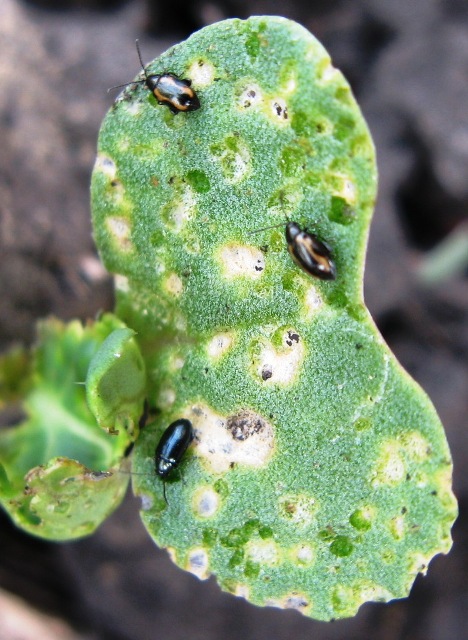Manitoba Insect & Disease Update: May 26, 2015
Summary
Current crop scouting priorities include flea beetles in canola and cutworms.
Flea beetles in canola: Flea beetles feed more actively on hot, calm days. Seedlings of canola that was seeded recently (within about the last 3 weeks) should still be effectively protected from flea beetles by the seed treatments. Research at Agriculture and Agri-Food Canada in Saskatoon found that neonicotinoid seed treatments (such as Helix and Prosper) were more effective in dry soils than in wet soils and more effective at 20C and 30C than at 10C. So if rainy and cooler weather returns, it is good to keep an eye on how much pitting to the seedlings is occurring, even though the flea beetles may not be feeding as aggressively.
For anyone reseeding canola because of frost damage or other factors, note that the seed treatment will provide you with some protection as the seedlings come up. So no need to be spraying to reduce flea beetle levels before reseeding.
How long does canola remain susceptible to flea beetles? A general guideline is that once the canola has 3 or 4 true leaves expanded, it will compensate well for feeding by flea beetles. Research in Manitoba found that yield was reduced most when plants were damaged during the seedling to second true leaf stage, but was not reduced when they were damaged after reaching the third to fourth true leaf stage.
The photo below shows the 2 most common species of flea beetles on canola in Manitoba, the striped flea beetle, Phyllotreta striolata, at the top of the photo, and the crucifer flea beetle, Phyllotreta cruciferae, at the bottom of the photo.

Cutworms: For the common species of cutworms in Manitoba, some, such as dingy cutworm, overwinter as partially grown larvae, while others, such as redbacked cutworms, overwinter as eggs. The size of cutworms that would be present currently would depend on the species that is dominant in the field.
So far there have been no reports of economical populations of cutworms. However, cutworms of species such as redbacked and darksided cutworm are likely still in their early instars, where feeding would result in small pieces of plant tissue being removed but little if any stem clipping yet. So if noticing some defoliation starting but no insects present, dig around the damaged plants to see if cutworms may be present. And note that at this point in the season they may be quite small caterpillars yet.
Insect Monitoring Programs
The following are the highest cumulative counts for the traps for adult diamondback moth in Manitoba as of May 26, 2015.
| Nearest Town | GO Team | Cumulative Trap Count |
|---|---|---|
| Portage la Prairie | Central Plains | 63 |
| Gilbert Lake | North Parkland | 46 |
| Morris | Red River | 42 |
| Durban | Valleys North | 40 |
| Swan River | Valleys North | 30 |
| Birch Lake | Valleys North | 28 |
Low to moderate levels of diamondback moth adults may have started to arrive in the East and Central regions of Manitoba the week of May 3 to 9, and in the Northwest agricultural region of Manitoba the week of May 10 to 16. Numbers overall are not very high, but it appears some moths have arrived. How economical this is likely to become is hard to say and depends on many factors, including weather and natural enemies that may either overwinter in Manitoba or potentially move in on the same winds as diamondback moth. Look for signs of feeding and larvae of diamondback moth during regular field scouting. So far there have been no reports of larvae of diamondback moth being found.
The parasitic wasp Diadegma insulare, one of the key natural controls of diamondback moth, is not known to overwinter in Canada, and is believed to migrate northwards with diamondback moth. It can be very effective at regulating diamondback moth population. This is one of the reasons to follow the general guidelines of scout fields well, and only apply insecticides when economic populations of pest insects are present. Applying an insecticide, or tank mixing in an insecticide with a herbicide when insects are not at economic levels, can inadvertently result in future pest problems if effective natural controls are removed.
Insect Identification Quiz
What mite these small red things on the soil be?

Some have asked about what these small bright red things are that can often be seem on the soil this time of year. These are red velvet mite, technically a mite and not an insect, although we still like them. The adults prey on insect eggs and other small arthropods. The immature stages of these mites are parasitic on grasshoppers and other insects.
Compiled by:
To be placed on an E-mail list so you will be notified immediately when new Manitoba Insect and Disease Updates are posted, please contact John Gavloski at the address or numbers listed above.
- John Gavloski, Entomologist
Manitoba Agriculture, Food and Rural Development
Phone: (204) 745-5668
Fax: (204) 745-5690. - Holly Derksen, Plant Pathologist
Manitoba Agriculture, Food and Rural Development
Phone: (204) 745-4248
Fax: (204) 745-5690
To report observations on insects or plant pathogens that may be of interest or importance to farmers and agronomists in Manitoba, please send messages to the above contact address.
To be placed on an E-mail list so you will be notified immediately when new Manitoba Insect and Disease Updates are posted, please contact John Gavloski at the address or numbers listed above.

